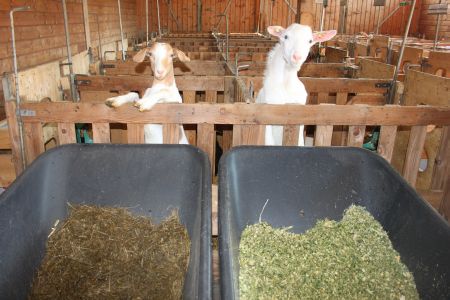The aim of this project is to collect comprehensive and holistic data on fattening and slaughter performance as well as the meat quality of lambs and kids under Austrian production conditions for the following aspects:
- Production-technical data on the total nutrient expenditure during fattening:
By determining the animal's individual feed intake during the entire rearing and fattening process (from birth to slaughter), the nutrient expenditure of lamb or kitten meat production can be determined depending on the genotype (pure-bred or cross-bred) and feed basis (basic feed ration ) can be calculated. From the results, the costs and efficiency of lamb and fawn fattening can be calculated at several reference levels, namely per kg of meat, per kg of gain, per nutrient unit of feed, per fattening day and per unit of area. - Influence of animal species or genotype and feeding or feed level on meat quality:
Meat quality is a decisive factor in consumers' purchasing decisions. The quality (tenderness, color, ingredients, fatty acids, etc.) of the meat is greatly influenced by what it is fed. The aim of this project is to investigate the influence of the basic feed ration and gender on meat quality. Genotype can also have an influence on meat quality. - Basics for economic calculations of lamb and fawn fattening under Austrian production conditions:
The experimental plan, ie the selection of different animal species (dairy sheep, dairy goat) with different feed levels, results in a wide range of effort/yield ratios, which also provide basic evaluations in economic terms allow. The input factors are wide-ranging (genetic predisposition, feed ration), so it is also to be expected that the output (meat performance) varies greatly depending on this. This makes it possible - by using model calculations with different price/cost ratios - to make basic economic statements about lamb and kid meat production under very different production conditions. - Basis for ecological statements on lamb and kid meat production under Austrian production conditions:
The very different effort/return ratios mentioned under “Economics” - due to the experimental design - also lead to significantly varying conditions in ecological terms (environmental impact). The genetic differences of the laboratory animals mean different efficiency of nutrient utilization, which has an impact on the environment. The use of grassland feed (grass silage) instead of corn silage must also be evaluated in terms of efficiency and ecological balance. Here too, model calculations are carried out on the basis of fully recorded production data from the test.
The present project is part of the Dafne project 100980/2 , which is about economical and, if possible, ecological sheep and goat milk production under different production conditions.







